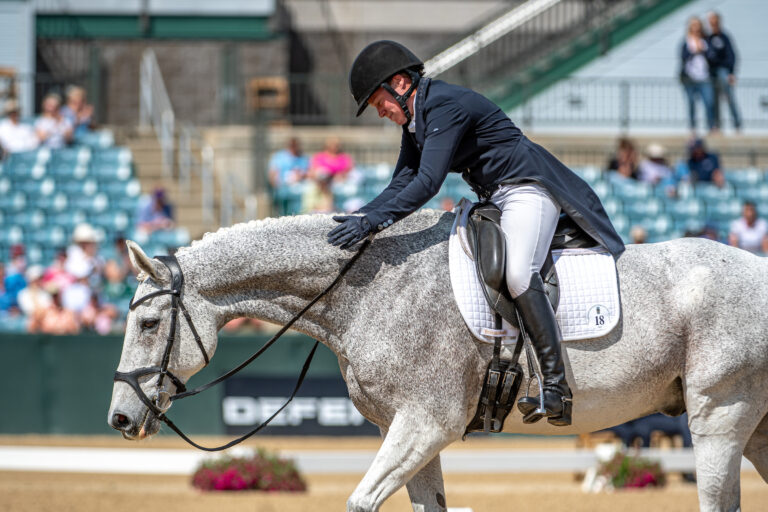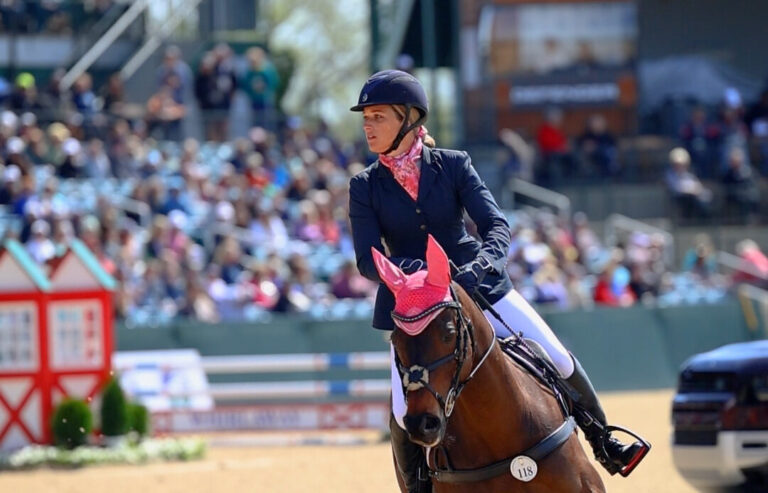After I graduated from the pony ranks, a Thoroughbred named The Federalist took me to what was then the North American Young Rider Championships three times, where I medaled every year. Then my first project horse was a little chestnut Thoroughbred. We got him from Jazz Napravnik, the sister of champion jockey Rosie Napravnik. Daybreak was his show name—we called him Kid. I evented him through Training level but had to sell him before I went to college because that was my parents’ deal with my brother, Doug, (who rode a different horse) and me. Ever since, I’ve found I prefer Thoroughbreds to warmbloods for eventing. I save money, time and travel by buying American horses off the racetrack rather than going to Europe.
Why Thoroughbreds?
Thoroughbreds aren’t as dominant in the sport as they were in the days of the classic three-day event format, where the cross-country test followed the steeplechase and roads-and-tracks phases. Their natural endurance and stamina made them ideally suited to that longer format although the challenges at the three- and four-star level today still require that type of endurance. Even though the speed and endurance phases have been eliminated in competition during this era, I’ve found that Thoroughbreds can hold their own with those warmbloods who became popular as the dressage and show-jumping phases gained more importance and the test on cross-country day was shortened.
True, you don’t get the same movement for dressage with typical Thoroughbreds as you get from most warmbloods. With the ability to be “wow” movers, warmbloods generally don’t have to be as well trained as Thoroughbreds. Since the warmbloods can get away with more because of their flashy movement, the Thoroughbreds have to be that much more precise.
But these days, everyone who’s buying a cross-bred for the top of the sport wants to know the bloodlines, making sure they include enough Thoroughbred.
When I went to Burghley and Blenheim in September, I was so happy to be on Thoroughbreds. Both events were run in pouring rain on cross-country day. At Burghley, where I rode Never Outfoxed, conditions got much worse as the afternoon went on during what many call the world’s most difficult four-star.
With the undulating ground, Burghley is hard enough in good weather. I was second to last to go, watching as the ground deteriorated and it took so much out of the horses. Phillip Dutton had ridden before I did and he told me that partway through the course, “They’re going to be really tired. You’re really going to have to help them. By the time you get to the Leaf Pit at the end, they’re going to back off and you really have to get after them.”
I didn’t experience any of that. Foxy was super confident. He stayed strong and motivated the whole time and still had run left when I reached the finish line. I was even struggling to pull him up. Had I not been on a Thoroughbred, I don’t think I would have gotten around.
At Blenheim, I went during the middle of the day, but the rain had made the course more difficult. Santino was up to the challenge while I saw other horses getting discouraged. It was very rare to make the time or get close to it. It definitely was an advantage to be sitting on a Thoroughbred, and I was thrilled to finish 13th.
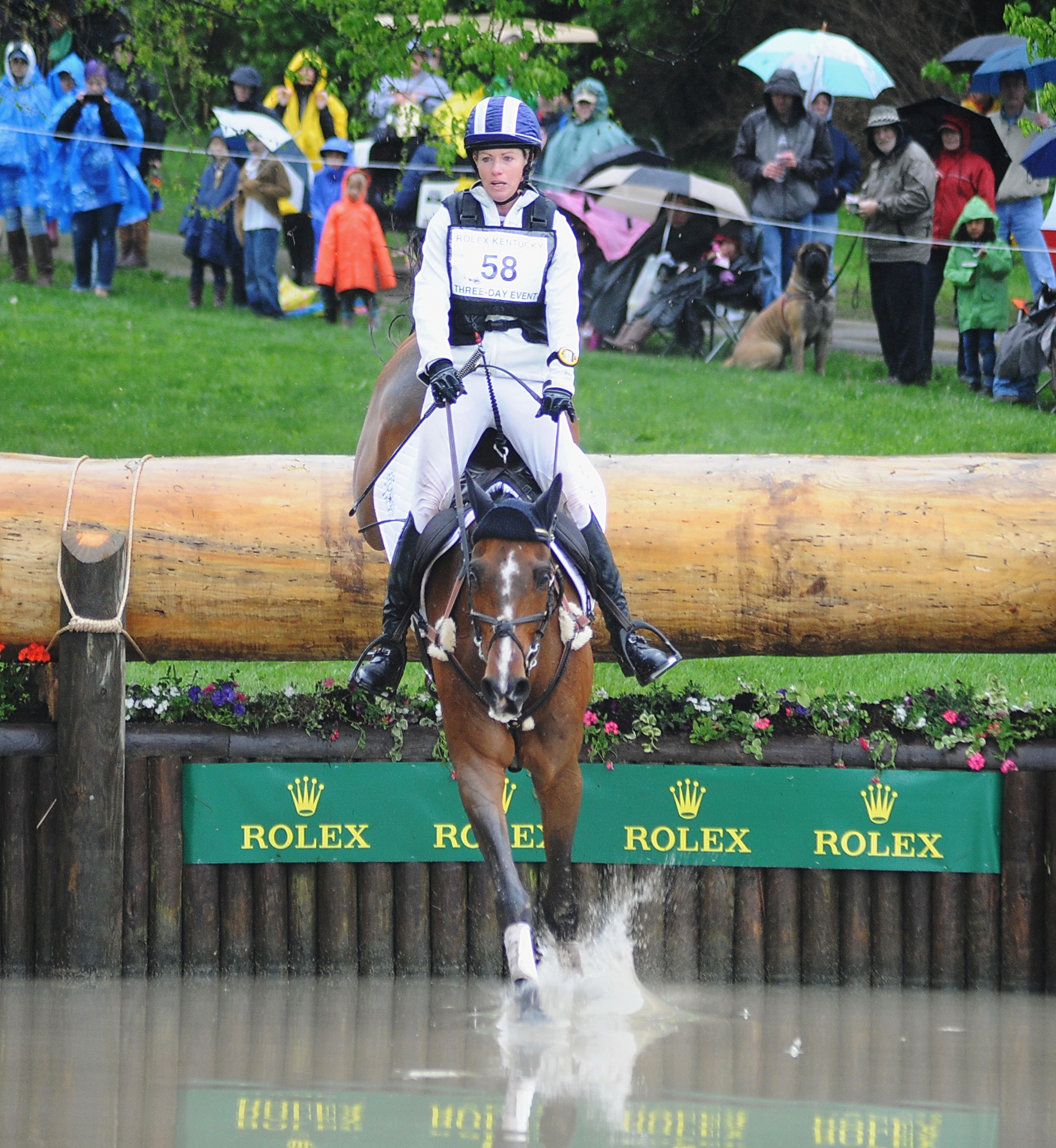
Luckily, the Thoroughbreds I have picked and ridden can stand up to warmbloods movement-wise. But they were competitive in the dressage phase because they also had the right brain—that is, they were agreeable and trainable. This is critical because of the breed’s ability to run and jump all day long, which is not necessarily what you want in the dressage. When you’re trying to produce a relaxed, accurate test, you need to be able to contain the Thoroughbred’s endless energy.
Thoroughbreds also tend not to be as careful in the show-jumping phase as warmbloods. Those horses are generally bred for dressage and show jumping, while Thoroughbreds are bred for galloping, speed and endurance. This can mean that Thoroughbreds jump a bit more flat and quick, which may make them a little less careful.
When it comes to cross country, though, I’d rather be on a Thoroughbred because they have the heart and will to go forever. With warmbloods, I feel as if when your token runs out, they’re out. Even if a Thoroughbred is tired, he will rally and keep going for you. I want to be on something that’s still taking me to the jumps at the end of cross country.
Another plus for Thoroughbreds is that they require less conditioning. They stay naturally fit. You have to be much more diligent about conditioning warmbloods. So many times before a big competition, something happens and you miss gallops. You can get away with that if necessary with a Thoroughbred because you have more flexibility fitness-wise than you do with a warmblood.
Thoroughbreds tend to be a little bit sensitive, but once you have a relationship with one, it works to your advantage. I find them easier to train than some young warmbloods. I’ll have a 3- or 4-year-old Thoroughbred trained in no time. Warmbloods don’t have the same catlike reflexes and body awareness; they take a long time to develop instinctive reactions. Their bodies require more time to mature and their brains work a bit slower. I find they can check out on you a little bit more when you’re trying to train them—and take off bucking, rearing or leaping.
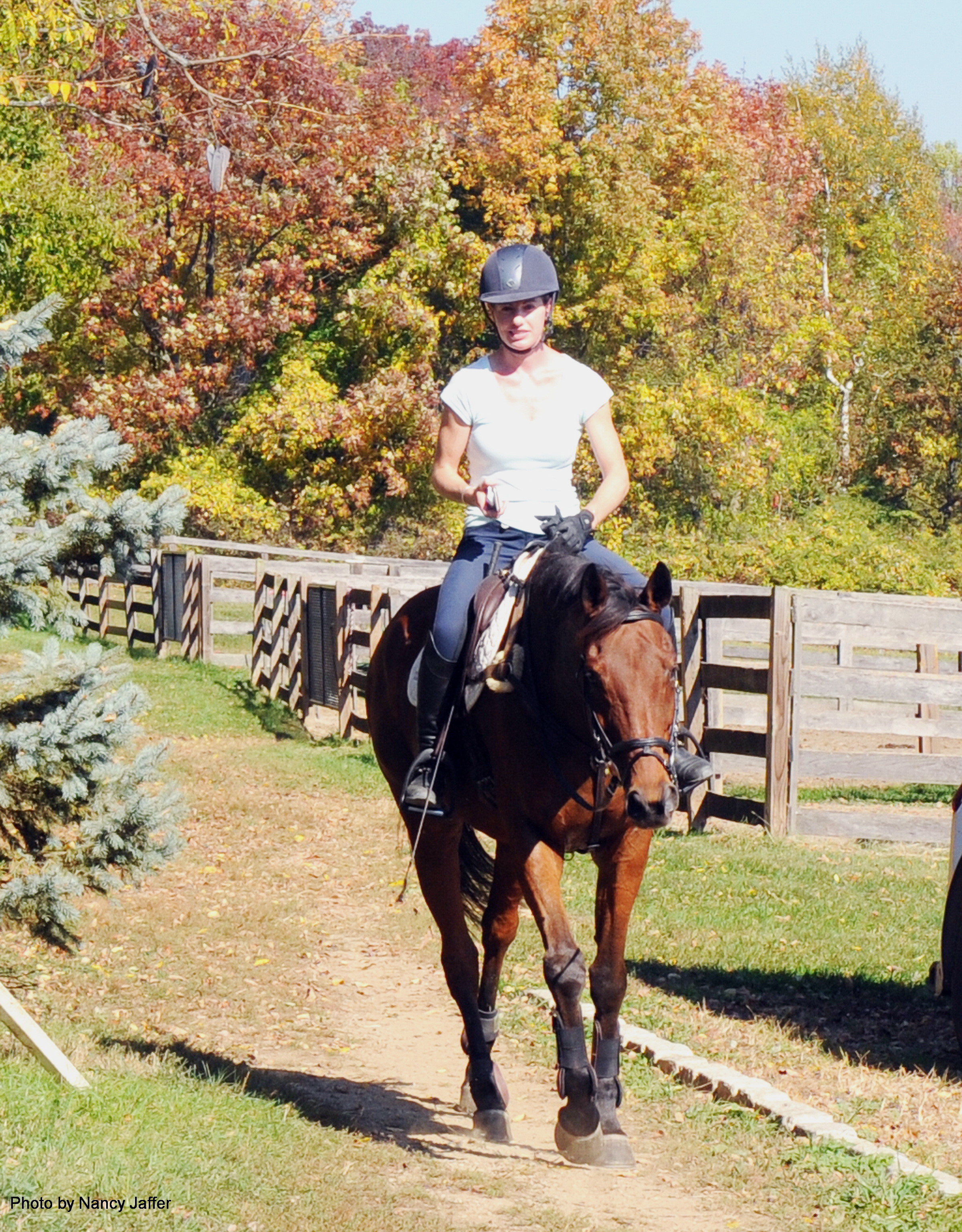
Most Thoroughbreds, even if they get frightened, tend to stay with you mentally. They have a little more self-awareness. They do tend to worry, however, and need a rider with a secure position. Especially as young horses, they are more sensitive and aware so they are affected by subtle movements made by the rider if he or she starts to get unseated. They feel the tension of an uncertain rider, but conversely, if the rider stays confident and steady in the saddle, they gain reassurance.
I see people who just want to do lower-level dressage at local shows but feel they need to get a warmblood for that. They think ex-racehorses are crazy or can’t be quiet or amateur-friendly enough. Then they get warmbloods who buck them off or spook and they can’t take them out of the indoor ring. They don’t realize that once off-the-track Thoroughbreds are trained for their new work and more confident, they can make great mounts for amateurs and Young Riders, provided those riders have sufficient experience and are secure enough in the saddle. I have several students who have nice horses off the track at various levels.
Making a Comeback
There actually is a resurgence of Thoroughbreds in eventing. Approximately one-third of the horses at the Rolex Kentucky Three-Day Event last year were Thoroughbreds. After the 2014 Alltech FEI World Equestrian Games in Normandy, France, when many horses couldn’t finish the cross-country course because its ground conditions and design demanded so much endurance, there were lots of articles online about the need for Thoroughbred blood in eventing. The top-placing horses at WEG all showed a good percentage of Thoroughbred blood, which made people pay attention.
With programs such as the Retired Racehorse Project’s Thoroughbred Makeover and the Jockey Club’s Thoroughbred Incentive Program, along with increased media attention, people are beginning to understand that they can get a horse off the track without spending a lot of money if they are willing to put in the time and training themselves. You can’t take that approach with many other breeds.
As more and more people are going back to Thoroughbreds, prices are starting to increase for the good ones. Actually, in terms of horse welfare, that’s not a bad thing. As prices rise and horses become more valuable in the sporthorse market, racehorse owners and trainers will sell them as potential riding horses and won’t break them down by racing them too long in an attempt to earn more money with them.
There are still plenty of bargains out there, though. You can get a good prospect straight off the track for $5,000 or less in most places. (The most I’ve paid is $6,000.) As soon as they come off the track and someone puts a week or two of training into them, which may make them appropriate for amateur and young riders, the top price could go up to $7,500.
How to Find a Good One
It’s sometimes hard to find the best Thoroughbreds. There are so many out there that it’s a little bit of a numbers game. Not every OTTB is going to be an upper-level horse, but many can still become fabulous lower-level packers.
You could try a Thoroughbred rescue group as a source, but be aware that some have a provision prohibiting buyers from reselling their horses.
I buy horses off videos from racetracks out West. The Northeast tends to get a little tapped out because we have so many more eventers and jumpers as well as people who know about Thoroughbreds. Sometimes, if you go to a more remote area, where they’re not turning around as quickly, you can get a better find.
If you look at a Thoroughbred’s eye, you can get a read on his character. It takes practice, but you’ll get to the point where you can judge a sweet, sincere look. That’s important because a lot of times you won’t be able to ride a horse you’re buying off the track before your money changes hands. So you don’t necessarily know what you’ve got when you pick up a horse from the racetrack.
When I’m assessing horses, I look for conformation and movement. I tell the owners to just let them loose in the ring and video them. I want to see their natural balance. I want them to be uphill and light. They’ll stay so much sounder if they’re light on themselves and not heavy on the forehand. It doesn’t matter if they’re only 2 years old—you can see if they’re naturally balanced and can change leads.
If I like the look of a horse, I’ll do a vetting with someone from the area where the horse is stabled. I ask for a baseline set of X-rays of his feet, ankles, knees and hocks. Then I have the X-rays sent to my vet at home. I want horses to be clean-legged and sound. A lot of times, if they retire sound off the track, they’re pretty sturdy—and more likely to stay sound throughout their second careers.
Should anything come up in the course of the vetting, such as with the flexion test, I have the vet call me. If there’s a real problem, I’ll stop the process there. Ankles can be particularly unforgiving, so I tend to stay away from horses who have ankle issues.
I also consider some of the breeding when I make my selection. When I was a senior in college in Florida, I bought a horse from Michigan who was off the track. He had been started in a new career for a couple of months. He turned out to be an amazing mover and jumper, really sweet. He had everything you would want to have in an upper-level horse. The only problem was that once I got him to Preliminary, he was too timid to move up on cross country. He would keep trying, but you could tell he was scared. I ended up selling him to Phillip Dutton, who did a two-star with him and sold him to a Young Rider.
I had liked this horse’s attitude so much that I contacted the breeder and learned that his sire was a California stallion named Fruition. I told the breeder, “If you have any more of these Fruition horses, contact me. I’d be really interested.”
I got two others through that breeder. One is Cowboy, aka High Stakes, who never raced. His owners had started endurance riding him in Arizona. They sent me a video set to music. He was trotting and galloping with his head in the air on a straight line toward the camera, so you couldn’t see anything about his stride or way of moving. Then the cowboy riding him got off and tied his shoe—and the horse just stood there. After that, they threw a tarp over him and he still was motionless. I looked at the video and thought, “This horse is a saint.”
I wound up buying him as a resale project for next-to-no money. I figured a patient 5-year-old like that would be good for an amateur. After he made it through Preliminary I sold him to a student who competes at Training level.
The next horse I got from that bloodline was Fruition’s First, who had been on the track. I shipped him east from California as a 4-year-old and he went through Intermediate after winning the American Eventing Championships at Novice. I eventually sold him to a student as well.
How I Start OTTBs
When horses come off the track, I put them into work right away and get them going with groundwork and longeing. If you throw them out in the field, they’re kind of lost for a little while. They hate to be left to their own devices. My experience is that they like being in a program and having something to do every day. My event horses turn feral when they get time off. They’re harder to handle and fall apart a little bit.
After a new ex-racehorse arrives at my barn, I don’t put him into intense work. Instead, I treat him like an unbroken horse. Since I don’t know how he was broken or what he was like at the track, I begin with the basics.
I start with our OTTBs by turning them loose individually in the indoor ring. We use two people to keep them going so they step out and stretch, and they soon get the hang of it. When I free-longe like this, horses see the whole ring from different angles, so I move them in circles up and down the ring with the help of the other person. If you start by keeping them on one circle until they’re perfect and then you ride them around, they haven’t been able to take in everything, so they might say, “What’s that horse I see out the window? What’s outside that door?” I like them to see every part of the ring.
After that, we free-longe them in a small ring a bit in side reins adjusted fairly loosely at first before putting them on the longe line then adjusting the side reins as the horses progress so they get used to the concept of contact. Sometimes they panic when you ask them to go on a circle because they never go in small circles on the racetrack, but they figure it out. They also need to get used to going to the right because at the track they always go to the left.
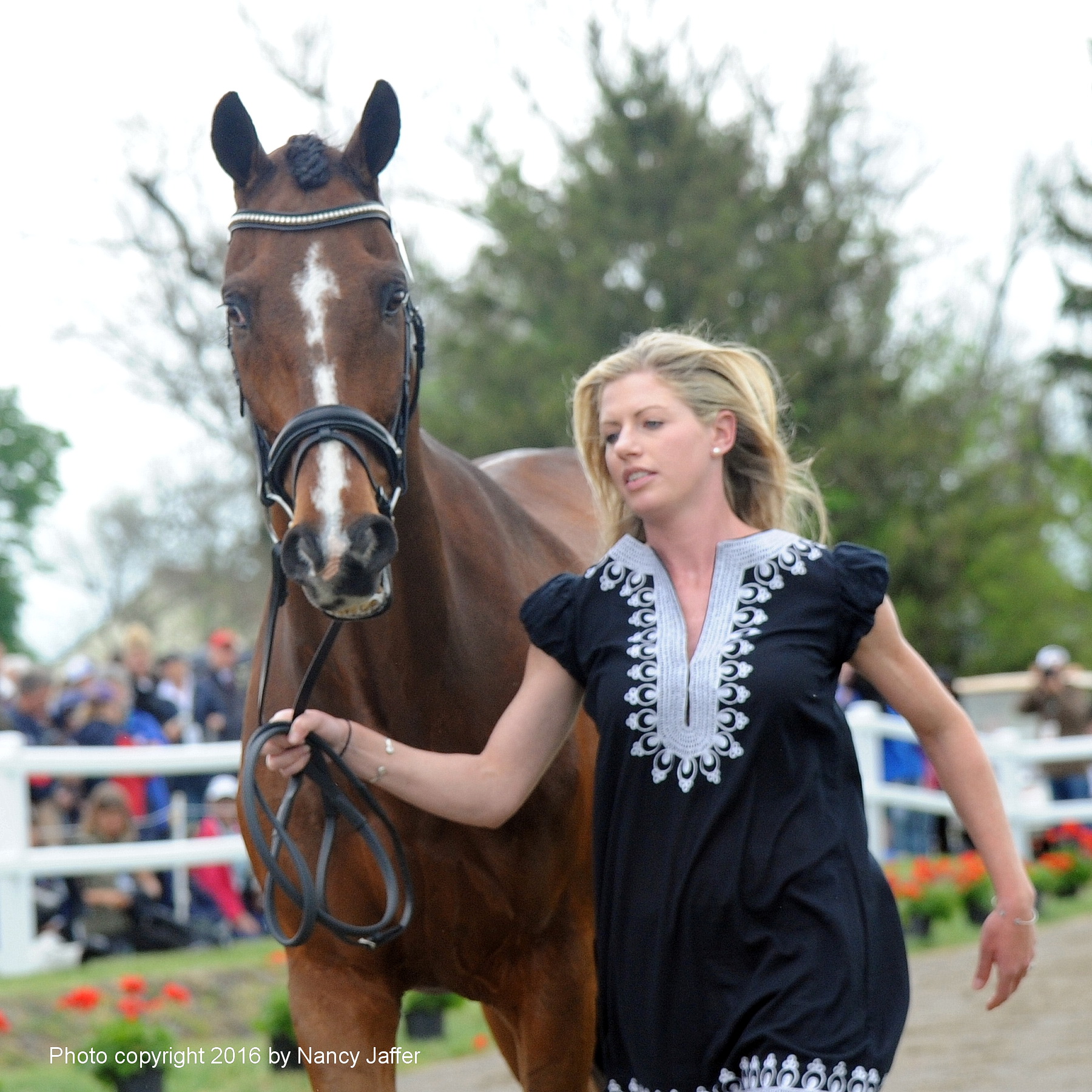
Once you build a relationship on the ground and have a better sense of what you’re dealing with, you can tailor your training plan to what your horse needs. I don’t start training them under saddle until they understand how to go forward, accept contact and know voice commands on the longe line. The time frame is a little different for every horse. Some pick it up in a week while others take a month. But for the most part, Thoroughbreds understand all the groundwork within one or two weeks and it builds a relationship. In my early under-saddle training with an OTTB, I walk him over a pole on the ground and do things to expose the horse to new experiences, from trail riding to going to small shows where he doesn’t compete. This also helps a horse to recover from flashbacks of his racetrack days.
Some horses handle the transition from the racetrack environment well; others need more time, especially if they get flashbacks. If you take an OTTB off your property in a group of horses, for instance, it can be a track flashback. Loudspeakers also trigger memories. One horse I trained was fine in the indoor, but when we opened the doors, he tried to bolt. Walking through the open doors was a flashback to the starting gate.
Once a horse can handle different environments and experiences confidently, I know that he’s ready to start a successful second career as an event horse.
Holly Payne Caravella comes from one of the United States’ most famous eventing families. Her mother, Marilyn Payne, is a well-known competitor and a top international judge. She was president of the ground jury at the 2016 Rio Olympics, which was the second time she has officiated at the Games. Holly and her brother, Doug, grew up riding together at the family farm in Oldwick, New Jersey, and both competed at the four-star Rolex Kentucky Three-Day Event last year. Doug has his own stable in North Carolina and is the author of The Riding Horse Repair Manual.
Holly is based at Shelby and Austin Godfrey’s Old Fox Farm in Chester, New Jersey, where 16 out of 20 horses in her barn are Thoroughbreds. She placed in the top 20 in Great Britain’s 2016 four-star Land Rover Burghley Horse Trials with Never Outfoxed Syndicate’s Never Outfoxed and the three-star Blenheim Palace International Horse Trials on Rob and Beth Groblewski’s Santino in September. Both are Thoroughbreds. That successful trip was followed by a seventh-place finish in October’s two-star with an up-and-coming Thoroughbred, Bruisyard Hall, at the Dutta Corp. Fair Hill International.
This article originally appeared in the February 2017 issue.






